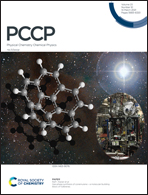Nanomechanics of antimonene allotropes under tensile loading†
Abstract
Monolayer antimonene has drawn the attention of research communities due to its promising physical properties. However, the mechanical properties of antimonene have remained largely unexplored. In this work, we investigate the mechanical properties and fracture mechanisms of two stable phases of monolayer antimonene – β-antimonene (puckered structure) and α-antimonene (buckled structure) – through molecular dynamics (MD) simulations. Our simulations reveal that a stronger chiral effect results in a greater anisotropic elastic behavior in α-antimonene than in β-antimonene. We focus on crack-tip stress distribution using local volume averaged virial stress definition and derive the fracture toughness from the crack-line stress. Our calculated crack tip stress distribution ensures the applicability of linear elastic fracture mechanics (LEFM) for cracked antimonene allotropes with considerable accuracy up to a pristine structure. We evaluate the effect of temperature, strain rate, crack-length, and point-defect concentration on the strength and elastic properties. The tensile strength of antimonene degrades significantly with the increase of temperature, crack length and defect concentration. The elastic modulus is found to be less susceptible to temperature variation but is largely affected by the increase in defects. The strain rate exhibits a power law relationship between strength and fracture strain. Finally, we discuss the fracture mechanisms in the light of crack propagation and establish the relationship between the fracture mechanism and the observed anisotropic properties.



 Please wait while we load your content...
Please wait while we load your content...